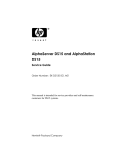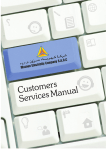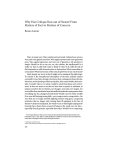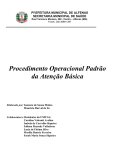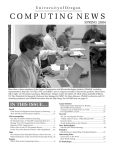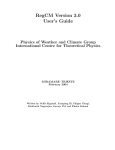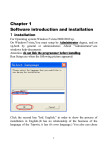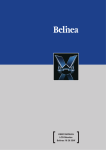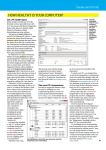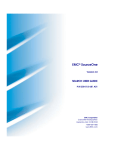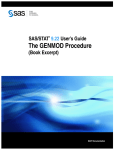Download C O M P U T I N G N E W S - Scholars` Bank
Transcript
U n i v e r s i t y of O r e g o n COMPUTING NEWS Spring 2005 The courtyard of the newly expanded Jordan Schnitzer Museum of Art on the UO campus. Now nearly twice its former size, the extensively redesigned and renovated museum reopened to the public on January 23, 2005. IN THIS ISSUE… Large Systems Time to Move Your Email Off Oregon .............................20 Darkwing: An Update on the New NetApp Filers.............2 Linux: Beyond RedHat and Fedora Core .........................21 Future of IT at the UO A preview of the 2005/2006 planning document .............. 3 Feedback on UO Home Page Send us your comments about our new search engines and Internet directories ........................................................... 18 Microcomputing Learn the Basics of Site-Licensing Software, and Save.....8 Budget Systems: Are They Right for You? .........................9 Need to Transfer Large Files? ...........................................22 Security Expanding Taxonomy of Unwanted Email: Phishing .......12 Threat of Instant Messenger Worms Grows .....................13 Security Alerts ..................................................................14 Windows PC Protection and You ......................................19 Educational Technology Resources YLC Pioneers Web-Based Language Labs .........................4 PLoS Gives UO Faculty Access to Research Results .........9 Networking NSRC’s 2005 Workshops Include Bhutan, Mozambique, Venezuela ..........................................................................5 Sharing Large Scientific Datasets with LoCI....................22 Statistics Data Coding for Logistic Regression with SAS ...............16 SAS Hot Fixes ...................................................................18 People Who’s Who at the Computing Center.................................6 Interesting Sites Cybercrime in the News ...................................................11 IT Workshops Human Resources’ Pilot Program Offers Online Computer Training to UO Faculty, Staff, Students ........................10 New! IT Workshops on Demand ........................................3 CD-ROM Workshops in the Docs Room............................. 4 Spring Workshop Schedule ............................................. 23 The New NetApp NearStore R200 Filers The newly installed filers are the heart of the new Darkwing Joe St Sauver, Ph.D. Director, User Services and Network Applications [email protected] In the Winter 2005 Computing News we provided an overview of changes that were underway to upgrade and reconfigure Darkwing (see “The New Darkwing: A Briefing” at http://cc.uoregon.edu/cnews/ winter2005/darkwing.htm ). COMPUTING CENTER COMPUTING NEWS VOL. 20 #2 Computing News is published quarterly by the User Services and Network Applications staff of the Computing Center. © University of Oregon 2005 Contact: Joyce Winslow [email protected] Photography: Dave Ragsdale [email protected] Joe St Sauver, Ph.D. Director, User Services and Network Applications [email protected] Website: http://cc.uoregon.edu/cnews/ Got Extras? If your campus department receives surplus copies of Computing News, you may return them to the UO Computing Center for redistribution. 2 One area where that article was necessarily vague was with respect to the production “filers,” or data storage units, that were still in the process of being procured as we went to press. Because those filers are now installed and are really the heart of the new Darkwing, we wanted to follow up with some information about them. What Filers Are We Using? The UO purchased a pair of Network Appliance R200 filers ( http://www.netapp.com/products/ nearstore/r200_ds.html ) to build the new Darkwing. Because network attached storage isn’t a particularly “sexy” part of computer and network systems, Network Appliance (NetApp) may not be a household name like Dell or Apple. Nonetheless, the company is the market leader in the network attached and unified storage market and according to Gartner, it controlled 52% of the market share as of 2004.[1] The R200 shares many features with NetApp’s more expensive filer lines, differing from its more traditional network attached storage devices primarily in that it uses inexpensive (slightly slower) ATA disks rather than far more expensive (and slightly faster) traditional SCSI drives.[2] In particular, the R200 runs the same NetApp Data ONTAP custom operating system that all other NetApp filers use (see http://www.netapp.com/products/ software/ontap.html ), and it offers, among other functions: 1. RAID data protection, which ensures that if a disk fails and needs to be replaced, the system can recreate the information that was on that disk from other members of that RAID set 2. The ability to take snapshots of the contents of a filer at a given point in time so that backups or other tasks can be performed from that snapshot without the need to limit ongoing activities 3. The ability to restore individual files from periodic snapshots 4. The ability to synchronize the contents of a primary filer with a second redundant/backup filer located at an alternate location on campus 5. The (eventual) ability to access data stored on the R200s, not just from Darkwing (via NFS), but also from Windows PC hosts on campus (via CIFS) You may have noticed the new filers are delivering snappy performance. This is evident in vastly improved web page load times and faster email performance. As part of the installation of the new production filer, Darkwing users now have a default quota of 250MB effective April 6th, 2005. Users who already had Darkwing quotas at or above that level will of, course, continue to have their higher value. As deployed, the primary and backup R200s each have 8TB of disk, however the R200s are extremely scalable and may be expanded to up to 96TB each as the university’s disk storage requirements grow over time. Notes [1] http://biz.yahoo.com/ bw/050323/235696_1.html [2} Unlike traditional database applications, the difference in speed between ATA and SCSI drives is immaterial for Darkwing’s “breadand-butter” applications, email and serving web pages. computing news spring 2005 Looking Ahead: Mapping the Future of Information Technology at the UO Computing Center and Library liaisons begin planning process… Deborah Carver University Librarian and Interim Associate VP for Information Services [email protected] The senior staff in the Computing Center, together with Library liaisons, have met several times during the past six months to hammer out a formal planning document for 2005/06. While the process did not meet the official definition of “strategic planning,” it does represent an important first step towards this critical dimension of IT service. In repeated surveys conducted by EDUCAUSE (a nonprofit association dedicated to promoting intelligent IT use in higher education), strategic planning is one topic that usually rises to the top of the list of major concerns for CIOs. It is especially important as campus needs and expectations rise faster than our budgets. The Computing Center/Library plan covers a full range of IT services. Some of the initiatives are already in motion; others are new. Projects include: introducing… free technology training workshops on demand computing news spring 2005 • improved support for research computing • providing redundant high-speed network services in the region • redesigning the UO website • investigating emerging telephony applications such as dual mode wireless • implementing an enterprise-level document imaging and management application for the University of Oregon Several of the initiatives will require collaboration with key stakeholders outside of the Computing Center. The plan will serve several purposes. It establishes our priorities as well as a system of accountability. While there may be mission-critical needs that require us to divert our attention during the year, the plan will help us to focus our efforts and attention on those projects that have the highest cost-benefit ratio for the campus. The plan is also a useful communications tool. It tells the university community what it can expect from IT services during the specified time period. And it allows for collaboration across internal divisions and with other campus services such as the library. There are as many approaches to planning as there are plans. In the future, it is likely that the process will evolve to become more strategic in nature. By that, we mean a careful assessment of our mission, our preferred future, the changing environment, and the evolving IT needs of students and faculty. Once that groundwork is established, we can be confident that we are moving in the directions that make the best sense for the institution. In response to the changing needs of the campus community, the UO Libraries have introduced Workshops on Demand, a new model for offering technology training to faculty, staff, and students. These workshops will replace the open enrollment workshops (see Spring Workshops, page 23) beginning in fall 2005, but members of the UO community can start requesting them now. The new training model will emphasize increased collaboration with faculty in integrating information technology skills into the curriculum. A list of training topics is on page 23 of this issue. Also see http://libweb.uoregon.edu/it/ondemand.html for full details. 3 Yamada Language Center Pioneers Web-Based ‘Virtual Language Labs’ Multimedia teaching tools are proving especially useful in honing oral skills Joyce Winslow [email protected] traditional language lab: a “virtual tape recorder” that provides basic recording and playback, a multimedia messaging system that allows teachers and students to communicate via text, audio, or video, and a customizable interactive survey and quiz maker (SQM) for instructors that can be used to collect speech samples as well as other types of input. The VLL utilizes two data base servers, a web server, and a FlashCom media server set up by the Computing Center’s streaming media specialist Tony Kay. Catherine Wiebe, a Senior Instructor in French, was the first to incorporate the new tools in her teaching, introducing them in her upper-level orals skills class during winter term. She found that the Message Board (MB) tool, which enabled online discussions and assignments, gave students more opportunity to speak and made it easier for her to provide timely individual feedback, both written and spoken, on their pronunciation and grammar. This term Wiebe intends to use the MB with second-term French students. If she’s able to arrange it, she may also use it for cross-continental communication, pairing students who plan to study abroad in Lyons and Poitiers with students who are already in France. A sample Message Board screen, with interactive message list on left and the instructor’s text message and video on right. The era of the cassette tape is drawing to a close—at least in the UO’s Yamada Language Center (YLC). Last May, the YLC received a grant from the UO’s Educational Technology Committee to help fund a webbased virtual language lab (VLL). Working with software developer Jim Duber ( http://www.duber.com ) and led by IT Specialist Ginny White, YLC staff produced three web-based teaching tools that extend or replace the CD-ROM Workshops Let You Learn at Your Own Pace 4 Thanks to the efficient use of multimedia, virtual language labs like YLC’s can make teaching less mechanical and a lot more creative. Because it frees individuals from having to be physically present in a classroom, the web-based approach also has the potential to serve far more students, any time, anywhere. You’ll find more details on YLC’s virtual language lab at http://babel.uoregon.edu/ortesol.html For more information on using one or more of these web-based teaching tools, send email to [email protected] UO faculty interested in using the YLC Message Board can sign up at http://babel.uoregon.edu/messageBoards/ Do you need to brush up on your Excel skills, master the ins and outs of Mac OS X 10.3, or get an introduction to JavaScript? There’s a series of workshops covering these and other topics that you can easily fit into your busy schedule. The Computing Center’s Documents Room Library offers a collection of training workshops on CD-ROMs covering such popular programs as the Microsoft Office products (Word, Excel, Access, and PowerPoint), FileMaker Pro, Photoshop, and InDesign, as well as web-development tools such as HTML, XHTML, CSS, and Flash. These CD-ROMs provide several hours of expert instruction and are available in levels ranging from beginning to advanced. They circulate for one week and are renewable twice, so you can take them back to your home or office computer and learn at your own pace. The Documents Room is located on the ground floor of McKenzie Hall (Room 175; phone 346-4406). You can check out our entire catalog at http://docsrm.uoregon.edu/ computing news spring 2005 NSRC’s 2005 Workshops Include Bhutan, Mozambique, Venezuela UO networking group also contributed to NSF forum of African and U.S. scientists photo by Jichen Thinley, DrukNet Joyce Winslow [email protected] Continuing its mission of providing educational programs and engineering assistance to regional networks around the world, the Network Startup Resource Center (NSRC) is planning to participate in at least a half-dozen workshops in as many countries in the coming year. Many of these projects are still in the works, but here’s a brief summary of recent activities and confirmed upcoming events: The NSRC began the year by presenting a network training session in Bhutan January 10-15. It was the first such workshop in that country, a preparation for Bhutan’s hosting the South Asia Network Operators Group meeting, “SANOG VI,” this summer. The Instructor Hervey Allen (right) presents Rinchen Tshering NSRC team will also be among the presenters at with a certificate of completion following the first-ever the SANOG VI summer workshops: Hervey Allen, network training workshop for system administrators in Sufi Frauq Abubaker (a colleague from Bangladesh), Thimpu, Bhutan last January. APNIC staff member Champika Wijayatunga, and Also on the 2005 agenda is an advanced workshop Philip Hazel of the Cambridge Computing Center on Internet routing techniques taught by UO network will provide instruction in IP Services during Track 2 engineers José Domínguez and Carlos Vicente as part of sessions July 16-20, with Hervey serving as track leader. WALC 2005 in Merida, Venezuela in July. The annual See http://www.sanog.org/sanog6/ for details. WALC event is a series of training workshops for IT Also in January, NSRC project manager Steve Huter technicians and professionals from Latin America and participated in the National Science Foundation meeting the Caribbean, emphasizing hands-on experience and the “Enhancing Collaborative Research on the Environment latest technologies. For more details about this workshop, in Sub-Saharan Africa (SSA),” serving as co-moderator see http://www.walc2005.ula.ve/taller4.html and rapporteur for a panel on information technology, A brief history of the NSRC. The roots of the NSRC communications, and data management. Afterward, project trace back to a volunteer effort by Randy Bush Dr. Frederick Semazzi, who co-chaired the meeting to support networking in southern Africa in 1988. The and helped to organize it, commended the NSRC for its NSRC was formalized in 1992 by Randy Bush and continuing contribution to international collaborative John Klensin with a grant from the National Science research by saying, “Because of its distinguished track Foundation, the first of several NSF grants to support record in network technology for developing countries, NSRC activities. The NSRC has been based at the UO NSRC is uniquely positioned to provide strategic guidComputing Center since 1996, working in cooperation ance and expertise to the follow on activities after the with various UO staff and faculty. SSA Workshop.” Dr. Semazzi is currently on the faculty at North Carolina State University in the Department of Since its inception, the NSRC has been supported by Marine, Earth, and Atmospheric Sciences. many partners in industry and academia who generously contribute in-kind equipment and materials, funding, and More recently, the NSRC has been gearing up for expertise to its activities. Among these are the Internet participation in AfNOG 2005, the sixth annual meeting Society, Cisco Systems, the International Development of the African Network Operators’ Group, which will Research Centre, and the Carnegie Corporation of be held April 18-25 in Maputo, Mozambique (see New York. For a complete list of current sponsors, see http://www.afnog.org/workshop2005.php). Steve Huter and http://www.nsrc.org/sponsors/ For more information about Lucy Lynch are helping to organize the event and UO NSRC activities, visit the NSRC website at Computing Center support specialist Joel Jaegli will http://nsrc.org/ provide instruction for the Internet Services track. computing news spring 2005 5 Who’s Who at the Computing Introducing two of our new systems analysts… Joyce Winslow [email protected] program in his chosen field of management information systems, and John graduated with a bachelor’s degree in May 2001. Following graduation, he stayed on at the university for another three years as a technical support person in the housing department. John’s programming background at WSU made him a good fit for his current job as a systems analyst for the Administrative Services and Computing Facilities group at the Computing Center. Serendipitously, one of his primary assignments is to help create a new module in Banner that UO Housing Department staff can use to manage day-to-day operations, as well as such tasks as processing housing applications, assigning housing, and billing. Aside from the novelty of being able to compare and contrast WSU and UO housing systems, John finds this project particularly interesting because it gives him a chance to create something new: “When the module is done, instead of saying ‘I fixed a problem there,’ I get to say ‘I made that.’ That’s a great feeling!” John Tomoso, Systems Analyst Administrative Services and Computing Facilities People often ask Hawaiian-born John Tomoso why he would ever forsake an island paradise to live in the Pacific Northwest. John’s answer is simple: he wanted to see more of the world. Had he stayed island-bound through college, John feared he might never leave, permanently settling down not far from the family home in Kahului, Maui. Instead, John chose to attend Washington State University in Pullman—not too far from home, but far enough away to be “different.” WSU offered a good Although he willingly admits enthusiasm for all the “typically nerdy” pastimes—Star Wars movies, video games, science fiction—John has many other interests. Chief among these are cooking (an art he’s practiced since childhood, whipping up everything from pancakes to Phad Thai) and music. John has played alto sax since junior high and was in both the marching band at WSU and later, a community band in Pullman. It’s likely that for a while at least, John’s domestic talents will get more play than his saxophone, because he’s soon to be married to his longtime girlfriend Christina, an interior architecture student at the UO. John popped the question during a romantic getaway to Paris in March, and the couple plan to wed in Hawaii within the next year. quick links … Comprehensive account management: http://micro.uoregon.edu/account/manage.html Read your email: http://email.uoregon.edu/ Change your password: https://password.uoregon.edu/ Reset your password: https://password.uoregon.edu/authorize/ 6 computing news spring 2005 Center: Meet Our Staff did have one of the first personal computers known to man, a twenty-pound Zenith “laptop.” The long, harsh Montana winters were conducive to reading, thinking, and fiddling with the computer, so Keith became well-versed in technology at an early age. When it was time to choose a college, Keith was ready for a complete change of scene. Aside from academics, his two biggest priorities were to experience a warm climate and a vibrant night life. He found all these and more in New Orleans, where he was able to satisfy his eclectic tastes in music (blues, funk, jazz) and graduate with a triple major in computer science, math, and physics from Tulane University. Tulane was also where he was first introduced to the sport of ultimate frisbee, and Keith competed with his team in the 2001 World Ultimate Club frisbee championships in Hawaii. Keith Bucher, Systems Analyst Administrative Services and Computing Facilities His first day on the job at the Computing Center, Keith Bucher showed up with his arm in a sling—the occupational hazard of being a serious ultimate frisbee competitor. Systems administration and ultimate frisbee may seem like an unlikely mix, but Keith is a multifaceted guy. Keith’s path to Eugene and a job at the University of Oregon was also not what one might expect. Keith was born and raised in Helena, Montana, the only child of a computer-teacher mom and a civil-engineer dad with pioneering spirit. His parents opted for a life of self-sufficiency in an old (circa 1915) solar-powered homestead outside of town. The Buchers had no phone and no TV, but they After graduation from Tulane, Keith worked at a New Orleans computer consulting firm for two years and then took several months off to explore the West, looking for the perfect place to settle. Ultimately, Eugene filled the bill—so much so that Keith bought a house shortly after arriving here in the fall of 2003. Keith joined the staff of the Computing Center in September 2004, after a programming stint with a local Internet start-up company called RealPro Systems. He helps maintain the UO Directory, DuckWeb, and Banner servers, and is currently working with Administrative Services’ principal technologist Noreen Hogan on a major LDAP (Lightweight Access Directory Protocol) project. When complete, the new LDAP programs will provide authentication for UO students, faculty, and staff who access UOnet, ensuring that the UO can control access to resources such as the wireless network, dialin modems, the virtual private network (VPN), and the Blackboard teaching and learning system. … quick links Forward mail: http://password.uoregon.edu/forward/ Remove mail forwarding: http://password.uoregon.edu/noforward/ Check your disk quota: https://password.uoregon.edu/quota/ Disable/re-enable spam filtering: https://password.uoregon.edu/allowspam/ Control how virus-sanitized email is handled: https://password.uoregon.edu/husks/ computing news spring 2005 7 License and Activation, Please! Learn the basics of site-licensing software, and save Patrick Chinn Distributed Network Computing Consultant [email protected] If this article were titled, “Save over $100 on your favorite software,” most of you would wonder, “What’s the scam?” Yet there is indeed a way to save money when purchasing software, and it is legal. The catch? You need to learn the fundamentals of computer software licenses. The basic rule of software licensing is, “One computer, one license.” For each computer on which you plan to run that software, you need to purchase one software license. For example, if you have purchased five new computers and wish to legally use Microsoft Office on each, you will need to purchase five individual licenses for Microsoft Office. There are occasional exceptions to this rule. Some software licenses allow the product to be used on a laptop with the following restrictions: 1. The primary computer is a desktop, and that computer is used predominantly. 2. Both copies of the software will not be used at the same time. The latter is sometimes called the “80/20 rule,” which refers to the amount of time (expressed as a percentage) that you spend using each computer. Using software under this rule works well for those who use a desktop computer at work for the majority of the time and use a laptop 8 for occasional work at home or while traveling. The “one computer, one license” rule often adds a few hundred dollars to the price of a new computer. Fortunately, the UO and its faculty, staff, and students can buy some software at education discounted prices. Most big name software companies offer special education discounts on their products. This software is functionally the same as the regularly-priced products. The UO Bookstore is an excellent source of educationally-discounted software. Some companies do not offer upgrade pricing on these software packages because the upgrade price is often the same as the education discount price. When you buy a shrink-wrapped software package at a store, you are purchasing the installation CDs, a software license, and (in some cases) manuals. A software license is legal permission granted by the software’s owner, its manufacturer, to you, the customer, to install and use that program on one computer. It is important to make a distinction between software licenses and packaged software because licenses can be purchased separately from the installation CDs and from the shrink-wrapped package. Software licenses cost a fraction of the regular price. For those who maintain a large number of computers, buying licenses (rather than shrink-wrapped copies with packaging and materials you may never use) can result in significant savings. Where Can You Buy Software Licenses? The University of Oregon has a business relationship with the Organization for Educational Technology and Curriculum (OETC) (http://www.oetc.org). OETC is a notfor-profit organization that negotiates price agreements with computer and software manufacturers and then passes along the discounts to its members, including the University of Oregon. OETC offers an à la carte purchasing system: you can buy packaged software (which they call “shrinkwrap”), installation media, or licenses in any combination you desire. The purchaser agrees to obligation to maintain one license per computer. The advantage of this system is that it allows computer lab managers to purchase one or two copies of the installation CDs for a product and as many licenses as are legally required. Some companies rely on the honor system to prevent software piracy. Others use one of several ways to enforce software licensing. These methods include serial numbers, product activation, and network serial number verification. Unique serial numbers are used to help track software piracy and for product activation and network verification. Activation enters your product’s serial number into the manufacturer’s database via the Internet. With network serial number verification, each product is installed with a unique serial number and the program, when started, checks for duplicate serial numbers on the local network. If another copy of the program with the same serial number is running, the second copy will not run. Now that you understand the basics, go forth and put this knowledge to use. Save yourself and your department money — and remember: One computer, one license. computing news spring 2005 Public Library of Science Offers UO Faculty Timely Access to Research Results UO faculty eligible for 10% discount on PLoS publication charges to all articles published in peer-reviewed PloS journals such as PLoS Biology and PLoS Medicine. Other soonto-be-published journals include PLoS Genetics, PLoS Pathogens, and PLoS Computational Biology. Ron Renchler Director, Library Communications, UO Libraries [email protected] Each year the UO Libraries pay a modest membership fee to the Public Library of Science (PloS) (http://www.publiclibraryofscience.org/) to help make the world’s scientific and medical literature a freely available public resource. PloS is one of the leading organizations in creating open access publishing models that speed up and improve access to critical findings in scientific research (see http://www.plos.org/journals/model.html). This movement toward open access to research results is one of the most promising developments in improving scholarly communications throughout the world. One immediate local benefit of the library’s membership in PloS is that the entire UO community enjoys full access A second, less well-known, benefit of PLoS membership is that UO faculty members receive a 10 percent discount on publication charges in all PloS journals. The library encourages faculty members to take advantage of these reduced publication fees by publishing their papers in PLoS publications. By taking full advantage of PLoS publishing discounts, UO faculty can help both the library and the international scholarly community move forward in distributing information more widely and equitably. Faculty can also support open access publishing by using Scholars’ Bank (https://scholarsbank.uoregon.edu/dspace/), the university’s institutional repository for archiving, storing, and distributing the results of their research. For more information on PloS and open access initiatives supported by the library, visit with your library subject specialist (http://libweb.uoregon.edu/colldev/ general/special.html) or contact Faye Chadwell, 346-1819, [email protected]. Apple Mac Mini Budget Desktop Systems: Are They Right for You? Joe St Sauver, Ph.D. Director, User Services and Network Applications [email protected] If you’re not a “power user” and are just looking for a bare-bones computer for browsing the web, sending and receiving email, and creating simple documents in Microsoft Office, you might be surprised to learn how inexpensive basic systems have become. For example, you can now buy a cute little Apple Mac Mini (1.25 GHz PowerPC G4 processor, 40GB hard drive, 256MB RAM, and a DVD-ROM/CD-RW optical drive) for under $500. Add an industry standard monitor, keyboard, and mouse (all of which you or your department may already have), plus whatever application software you’ll need to buy, and you’re all set to go for a fraction of what you might previously have paid for an entry level Apple (see http://www.apple.com/macmini/ ). computing news spring 2005 What if you prefer or need a desktop PC running Windows? At the time this article was written, the Dell Small Business website (select “Small Business” from http://www.dell.com/ ) was offering Dell Dimension 2400 PCs (Celeron 2.4GHz, 256MB RAM, 40GB hard drive, XP Home Edition) starting at just under $300 (including a monitor as part of the current promotion). In my opinion, that’s an amazingly low price. Given that sort of rock-bottom pricing, particularly if you’re running an aging PC with Windows 3.11, Windows 95, 98, ME, NT, or some other version of Windows that’s no longer supported, you really should be thinking about replacing it. As systems get increasingly “long in the tooth,” catastrophic hard drive failures become more likely, and security patches may no longer be routinely issued for your operating system. One caution: If you are a power user, be careful how incremental adjustments to budget systems such as these can add up. If you start with a deeply discounted configuration or one with limited expandability and begin adding this or tweaking that, you may quickly find yourself paying more than if you had purchased a more suitable system to begin with. Be sure you understand the niche that these budget systems can fill, and limit their selection to times when that’s all that’s needed. 9 Human Resources’ Pilot Program Offers Online Computer Training to UO Faculty, Staff, Students This web-based training program can be used as a ‘virtual classroom’ or simply as a handy reference tool Joyce Winslow [email protected] This year Human Resources has contracted with RAA Training to provide web-based instruction in a wide range of business and computer skills, adding another opportunity for UO faculty, staff, and students to expand their expertise. These online trainings are billed to UO departments, and eligible employees may have a portion of the cost paid for by the Employee Benefit Fund. The program, which is being offered as a pilot project for twelve months beginning April 8, includes instruction in such mainstays as Microsoft Office (all versions) and Windows, as well as fundamental grounding in computer literacy and technical concepts. This pilot program offers great flexibility in its course structure. Once you’re enrolled, you can access the course site from any computer with an Internet connection, and you can learn at your own pace. You can stop a lesson at any time, and when you return to it the lesson will continue from where you left off. All courses include graphics, animation, optional audio narration, and real-world examples. Throughout the training you are presented with hands-on exercises that let you practice new skills as you learn them. The lessons are interactive, so you get and Computing Core Certification; and A+ 2003, which offers A+ computer technician certification). instant feedback on errors and have as many chances as you need to correct them. You may also assess your skills and progress by taking a test on any course either before or after training, including a “prescriptive” test that shows you only those lessons you need to learn. The program keeps track of all your work and test results, so you may document your progress if you need to. and an online registration form at this site. You can repeat any course, test, lesson, or page within a lesson as often as you like, and you may jump to any lesson topic at any time. This makes this web-based training system a valuable reference tool. Faculty and Staff: Faculty and staff may register individually or through their departments. Eligible employees may also have a portion of the fee for one library paid for by the Employee Benefit Fund. Another feature of the program is that you’re not required to own the software you’re studying or have it installed on your computer in order to learn to use it. The training module precisely simulates the use of all course software, freeing you to access the training from any computer connected to the Internet ( see the system requirements at Students: If you’re a currently enrolled UO student, you may use the online registration application at http://www.raatraining.com/ setupinfo.htm ). Registering for Courses When you register, you sign up for a training “library,” or collection of online courses. There are three libraries to choose from (PC & Business Skills, which is approved as preparation for Microsoft Office Specialist Certification; IC3 Internet All of these course libraries are described in more detail on the UO Human Resources training page at http://hr.uoregon.edu/training/raa.html You’ll also find a list of course fees http://hr.uoregon.edu/training/raa.html Submit your UO email address and enter “STUDENT” in the affiliation box of the form. A representative of RAA Training will contact you regarding payment. Note: UO faculty, staff, and students may register individually at any time during the 12-month contract period of the pilot program (April 8, 2005, through April 7, 2006). Allow 5-7 days for activation. If you have further questions about the web-based training program, contact Kathy Cooks, HR Programs Specialist, at 346-2939, or email [email protected] FileMaker Pro Essentials Course Online: For the convenience of off-campus students and community members, Mary Harrsch has posted her FileMaker Pro Essentials course materials online at http://interact.uoregon.edu/techweb/COEworkshops.html Mary is the Network and Information Systems Manager for the College of Education. Thanks, Mary! 10 computing news spring 2005 « cybercrime in the news » Top Phishing Scammer Nabbed in Brazil Three Enter Guilty Pleas for Software Piracy In mid-March, Brazilian police arrested the suspected leader of a phishing gang that stole an estimated $37 million from online banking accounts in the last three years. Considered one of Brazil’s biggest gangs of online con artists, Paulo de Almeida’s mob sent out over three million Trojan-laden emails per day, targeting customers of Brazil’s online banking websites and tricking them into divulging personal information. For details, see Three men who made millions of dollars’ worth of copyrighted software freely available for copying on the Internet say they did it simply for sport. For details, see http://www.theregister.co.uk/2005/03/21/ brazil_phishing_arrest/ Cal State Chico Hacked 59,000 California State University students, former students, prospective students, and faculty were recently notified that their personal information, including Social Security numbers, may be in the hands of hackers. As of March 21, officials were not yet certain that hackers had used the sensitive information, only that they had gained access to it. For details, see http://www.reuters.com/news/ Article.jhtml?type=technologyNews&storyID=7964776 Weak Link in IRS Security A recent security audit of IRS employees and managers found that more than one-third could still be duped into giving out their network ID and password to callers posing as IT technicians. The ruse was not an actual hack attack, as the callers were Treasury Department inspectors gathering data for a security report. For details, see http://www.securityfocus.com/news/10708 Anti-Phishing Services Court Banks Some financial institutions are turning to anti-phishing services for help in combatting email scams committed in their name. For details, see the Washington Post article, “New Industry Helping Banks Fight Back,” at http://www.washingtonpost.com/ac2/wp-dyn/ A6367-2005Mar4?language=3Dprinter ChoicePoint ID Thieves Sentenced In March, scammers who profited from stealing sensitive personal data from ChoicePoint Services were sentenced to spend time in federal prison. Adedayo Benson and his sister Bibiana were convicted of posing as a real estate agents to open accounts with several public records database firms, including ChoicePoint, and using the data they accessed to commit ID fraud. For details, see http://www.usatoday.com/tech/news/computersecurity/ infotheft/2005-03-08-choicepoint-conviction_x.htm Questions are also being raised about the quality of some of ChoicePoint’s data files. People are coming forward who have discovered gross errors in their files—everything from fictional criminal histories, purchases, and relationships to (the ultimate error) reputed deaths. See http://www.msnbc.msn.com/id/7118767/ computing news spring 2005 http://www.msnbc.msn.com/id/7128957/ University of Arizona Student Convicted of P2P Copyright Violations An Arizona student is the first person in that state to be convicted of intellectual property violations for illegally downloading music and films from P2P networks. In exchange for pleading guilty, he was fined $5400 and sentenced to three years’ probation and 200 hours of community service. For details, see http://www.theregister.co.uk/2005/03/08/arizona_p2p_boy/ Harvard Business School Rejects Applicants Who ‘Peeked’ 119 applicants to Harvard Business School couldn’t resist following a hacker’s instructions to peek into the school’s admission site to view the status of their applications, and as a result their applications are being thrown out. The hacker’s tip was posted on a BusinessWeek online message board. For details, see http://www.securityfocus.com/news/10634 Mobile Phones Hit By Spam Researchers for Wireless Services Corporation report that spammers are targeting mobile phones with increasing frequency. According to their report, almost half of all mobile phone text messages received in the U.S. are now spam. For details, see http://www.newsfactor.com/story.xhtml?story_id=30806 Spammers Target Email Directories So-called “directory harvest attacks” (DHAs) against company email servers are the latest tactic used by spammers. In an attempt to find valid email addresses associated with an email server and add them to a spam database, DHAs often send a message to all possible alphanumeric combinations. The result is similar to a denial-of-service attack, and can go undetected by routine spam filters. For details, see http://www.vnunet.com/news/1160987 Mobsters Move into Phone and Internet Fraud Six men with ties to the notorious Gambino family have pled guilty to consumer fraud in phone and e-commerce schemes that netted $650 million. For details, see http://www.crime-research.org/news/16.02.2005/965/4 Thieves Steal Defense Contractor’s Info The names, Social Security numbers, and contact information for 45,000 current and former Science Applications International shareholders fell into the hands of thieves during a burglary in January. For details, see http://www.securityfocus.com/news/10419 11 The Expanding Taxonomy of Unwanted Some basic precautions can help you avoid ID theft Joe St Sauver, Ph.D. Director, User Services and Network Applications [email protected] If we were to talk about a taxonomy of unwanted email, there are some forms that are unfortunately all too familiar: • viruses, worms, trojan horses and other email-borne infectious malware • pillz spam, porn spam, mortgage spam, and other spam for a variety of dubious or illegal products • 4-1-9 advance fee fraud scams, online lottery scams, and other con games conducted by email • pump-and-dump stock fraud, whereby penny stocks are hyped to unsupportable levels, only to be quickly sold by those who’d hyped them In addition to these, another form of unwanted email has recently become common: phishing (pronounced “fishing”) email messages. Phishing email messages attempt to con you into believing that your bank or brokerage (or your credit card company, or an online merchant, or perhaps eBay/PayPal) needs you to urgently “confirm” the details of your account with them. If you fall for that ruse and dutifully “confirm” your account number and provide your password or pin, miscreants will use that information to clean out your account or to order merchandise in your name. In the old days, ruses of this sort were easily spotted: the solicitations were crudely executed and often 12 contained spelling or grammar errors that might make people wary. These days, however, the quality of phishing emails has become quite professional, making them virtually indistinguishable from legitimate messages. We therefore urge you to: online crooks have been known to register look-alike URLs that take advantage of common typographical errors or omitted punctuation in an effort to snag customers who are trying to visit legitimate online commerce sites. • Never, under any circumstances, click on any links you may receive in an email solicitation • Never, ever, provide sensitive information in response to any email you may receive • If in doubt, use the phone to call your bank, credit card company, or other business, using the number that’s on your bank statement or the back of your credit card (don’t trust a phone number that may be provided in what may turn out to be a phishing email message) • Pay attention to any certificaterelated warnings you may receive. Certificate-related warnings may be a sign that you’re not dealing with the site you think you are! When you initiate a visit to a website to perform a financial transaction, whether ordering merchandise or paying bills online: • When you’re done, be sure you completely log out from the site you were using, and be sure to also completely quit the browser you were using. • Don’t use a computer in a cyber cafe or other public space; there’s no way you can tell what sort of snooping software or spyware may be on the system from an earlier user. Use your own computer instead, and be sure your antivirus software and antispyware software are upto-date and have scanned your system recently. • Be sure you’re running the latest version of a secure browser, such as (at this time) Firefox 1.0.3. Some other browsers, including earlier versions of Firefox, may have known security vulnerabilities which can be triggered by nothing more than visiting a “booby-trapped” web page. • Be careful to ensure that you correctly enter the exact URL of the site you’re trying to visit; • Beware of autocompletion of online forms and password fields: some browsers will try to “help” by automatically saving your account information (potentially including your password) in the browser’s settings; this can be a disaster, particularly on shared PCs in labs or other public areas. Don’t simply close the browser window you were using (someone may be able to pop up a new browser window and do additional transactions as “you”). Technically inclined users will also want to review and delete any cookies or temporary files left cached on the system. • You may want to periodically request a free credit report to ensure that no one has obtained credit cards or other financial services in your name without your knowledge. For more information on obtaining free credit reports, see http://www.ftc.gov/bcp/conline/pubs/ credit/freereports.htm If you do ever mistakenly provide private account information to a fraudulent site, or if you notice computing news spring 2005 Email: Phishing unauthorized charges or withdrawals on a monthly account statement, you should immediately contact the security department of that financial institution or merchant. In many cases your financial institution can take steps to limit your exposure, or they may even be willing to fully or partially reimburse you for your losses, but they need to hear from you as soon as you notice anything amiss. If you’re a UO faculty member, staff person, or student and you receive phishing email messages on your Darkwing or Gladstone account, you should report them as you would any other Darkwing or Gladstone spam: within a day or so of the time the message was sent, forward a complete copy of it with full headers (http://micro.uoregon.edu/fullheaders/) to [email protected] Learn More About Phishing 1. Anti-Phishing Working Group: http://www.antiphishing.org/ 2. How Not to Get Hooked by a ‘Phishing’ Scam: http://www.ftc.gov/bcp/conline/pubs/ alerts/phishingalrt.htm 3. Mail Frontier Phishing IQ Test II: http://survey.mailfrontier.com/ survey/quiztest.html 4. U.S. Senate “Anti-phishing Act of 2005,” S.472: http://thomas.loc.gov/ Threat of Instant Messenger Worms Grows Follow these tips to avoid infection Trevor Sehrer Student Security Engineer User Services & Network Applications [email protected] As the use of instant messaging software such as AOL Instant Messenger, MSN Messenger, and Yahoo! Messenger grows, so to does the threat of infection by instant messenger (IM) worms. Recently, there has been a tremendous increase in the number of IM worms out in the wild. According to the IMlogic Threat Center, over 30 new threats to instant messaging software have been recorded since the beginning of 2005 alone. Unlike traditional worms, IM worms have the advantage of propagating in an environment with a built-in list of potentially vulnerable hosts. While a regular worm needs to scan for future hosts to attach to, the buddy lists that are an intrinsic part of IM software help take the guesswork out of finding new hosts to infect. This is similar to how email-borne viruses spread through address books. As with email-borne viruses, IM infection requires some form of user participation, such as clicking on a link or accepting an unsolicited file transfer request. Fortunately, IM attacks have not yet wreaked the havoc caused by earlier infestations such as CodeRed or Sasser, but many experts feel it is only a matter of time until worm authors find a way to allow the worm to spread without requiring user intervention. computing news spring 2005 What Can You Do to Protect Yourself? Absent removal of IM software, there are a number of things you can do to help mitigate the IM worm threat: 1. Don’t click on unsolicited links. While chatting, if out of the blue you receive a file transfer request from a colleague, or a URL that contains a link to an executable or rarely seen file format (.PIF for example), spend a few keystrokes validating the identity of the sender. 2. Update, update, update. Most vendors release updated versions of their IM clients on a regular basis. When you update, not only do you get new software that often includes additional features and bug fixes, but you also lower the risk to your computer should a high-level IM worm threat emerge. 3. Enterprise users should use enterprise class IM software. Many software vendors sell corporate and institutional software suites for consumer IM clients. These enterprise class software packages use cryptography and other features to help protect the interests of large businesses. In addition, they provide a more secure infrastructure that is less friendly to IM threats. 4. Use a different client. Since IM worms are crafted to target a specific client, by using a client such as Gaim or Trillian, you not only receive the benefit of having multiple IM protocols in one client, but you also substantially reduce your risk of becoming infected with an IM worm. Following these tips will give you a leg up on providing a strong measure of security against the current onslaught of IM worms, as well as helping you guard against future threats. 13 Security Alerts… — Microsoft Windows— Reminder: No More Patches for Pirated Copies of Windows By mid-year 2005 Microsoft will require customers to verify that their copy of Windows is legitimate before allowing them to download software patches. Verification will be mandatory in all countries for add-on features and operating system updates—including security patches! http://news.com.com/This+week+in+Windows/ 2100-1016_3-5554824.html Microsoft Releases Eight Critical Patches in April After taking a break in March to conduct further tests on its fixes, Microsoft announced more critical patches during its April 12 webcast. The new releases include patches for Microsoft Windows, Office, MSN Messenger, and Exchange. In addition, Microsoft released an updated version of its malicious software removal tool and two high priority non-security updates for Windows. Note that the malicious software removal tool will not be distributed via Software Update Services (SUS). For details, including links to Microsoft security tools and update services, see http://www.microsoft.com/technet/security/bulletin/ advance.mspx New Worms Target MSN Messenger Kelvir.B Worm: The rapid spread of the Kelvir.B worm is posing a serious security threat to users of MSN, Microsoft’s Internet messaging service. When message recipients click on a URL on a message reading “lol! see it! u’ll like it!” the worm spreads to everyone else on their contact list. For details, see http://www.vnunet.com/news/1161784 Fatso.A Worm (aka Crog and Sumom): Like Kelvir.B, this worm spreads via MSN Messenger by including a booby-trapped URL in a message from “Sky Devil” that, when clicked, activates the virus. It also spreads as a file on eMule P2P (peer-to-peer) systems. This worm is spreading very rapidly in the wild, especially in the U.S. and South Korea. For details, see http://www.vnunet.com/news/1161781 Finding Microsoft Security Downloads To search for patches for Microsoft products, go to the Microsoft Download page at http://www.microsoft.com/downloads/search.aspx?opsysid= 1&search=Keyword&value='security_patch'&displaylang=en 14 — Viruses, Worms — Virus Authors Collaborate Security researchers suspect the authors of the Bagle, Zafi, and Netsky viruses are now collaborating on code that harvests email addresses from infected machines. Kaspersky Lab investigators warned that this signals a trend toward “the increasing criminalization of the Internet.” See http://www.vnunet.com/news/1161786 Growing Threat of Instant Messaging Worms Menaces Cell Phones, Too F-Secure researchers are reporting that Instant Messaging (IM) worms are the new virus of choice for Internet criminals because they spread much more rapidly via IM than email. The security firm also noted that more than 50 percent of last year’s largest viruses were “mobile malware” designed to defraud mobile phone users.* For details, see “IM viruses increase by 50 per cent a month” at http://www.vnunet.com/news/1162017 *Also see “Spam Hitting Mobile Phones Hard” at http://www.newsfactor.com/story.xhtml?story_id=30806 Protect yourself: To learn some basic steps for protecting yourself against IM worms, see Trevor Sehrer’s article, “Threat of Instant Messenger Worms Grows” on page 13 of this issue. W32.Sober-K-mm Worm In recent months, spam purporting to be from the FBI has been circulating in the wild. Subject headers typically are along the lines of “you visit illegal websites” and the message recipients are warned that their Internet use has been under surveillance. However, note that subject lines and message text are created randomly and can vary. If you receive such email, be aware that it is in fact the vector for the W32.Sober-K-mm worm. The FBI encourages users receiving such emails to register a complaint at http://www.ic3.gov/ For details, see “FBI Alerts Public to Recent E-Mail Scheme” at http://www.fbi.gov/pressrel/pressrel05/022205.htm Also see the ComputerWorld article, “New Sober worm moving fast…” at http://www.computerworld.com/securitytopics/security/ virus/story/0,10801,99936,00.html Protect yourself: Please ensure that your antivirus definitions are up to date. Also, if you never want to receive any sort of .zip file by email, you have the option of silently blocking those files from your Darkwing or Gladstone account by visiting http://password.uoregon.edu/husks/ computing news spring 2005 …Security Alerts — Other Alerts — Symantec Flaws NAV Vulnerabilities Allow DoS attacks Symantec has issued patches for two security flaws that could produce denial-of-service attacks on computers running its Norton AntiVirus software. The flaws, which are limited to versions of the software released for 2004 and 2005, were detected in the AutoProtect and SmartScan features of Norton AntiVirus. Symantec sent out automated fixes to its Automatic LiveUpdate service subscribers, and the patches are also available for download from Symantec’s security response website at http://securityresponse.symantec.com/avcenter/download.html For more details, see http://news.zdnet.com/2100-1009_22-5646871.html http://www.symantec.com/avcenter/security/ Content/2005.02.08.html Symantec’s Enterprise Products Vulnerable to DNS Cache Poisoning Use Eudora on Windows? Update to Eudora 6.2.1 to Avoid Critical Flaw If you’re a Windows user whose email program of choice is Eudora, be sure you’ve updated your version of Eudora to 6.2.1. Earlier versions are subject to attack by malicious code when a user opens or previews a specially crafted email. (Note that this vulnerability does not affect Mac users.) You may download the latest version of Eudora from http://www.eudora.com/products/ Update to Avoid Critical F-Secure Flaw If you run F-Secure antivirus products, be sure you download the patch that fixes a critical flaw reported in February. The bug, which is related to the handling of ARJ archive files, could allow hackers to execute malicious code and cause a buffer overflow. The patch is available from F-Secure’s website at http://www.f-secure.com/security/fsc-2005-1.shtml Flaws in Symantec Enterprise Firewall and Enterprise Security Gateway appliance products leave the door open to DNS cache poisoning, whereby unsuspecting web surfers can be rerouted to websites hosting malware. Even if you applied Symantec’s July 2004 fix to correct a similar problem, you should revisit the issue. For the full story, see For details, see the SearchSecurity.com article, “Critical flaw affects F-Secure products” at http://www.theregister.co.uk/2005/03/08/ dns_malware_attack/ If you haven’t kept up with your Apple updates, be aware that versions of iTunes prior to 4.7.1 are vulnerable to hacking. The problem stems from a boundary error in the iTunes playlists that could allow the execution of malicious code on your computer. The vulnerability has been rated “highly critical” by the Danish security watchdog firm Secunia. The solution is to update iTunes to version 4.7.1 See http://www.apple.com/support/ A security update is available from Symantec at http://securityresponse.symantec.com/avcenter/ download.html Impact of Flaw in Symantec’s Antivirus Scanning Module Wide-ranging Products ranging from consumer desktops to large corporate mail servers could be affected by a flaw in Symantec software that was reported in February. Product-specific hot fixes and updates are available through the Symantec Enterprise Support site at http://www.symantec.com/techsupp/ References: http://news.zdnet.com/2100-1009_22-5569811.html http://www.symantec.com/avcenter/security/ Content/2005.02.08.html Scanning Suspicious Files with VirusTotal http://searchsecurity.techtarget.com/originalContent/ 0,289142,sid14_gci1056615,00.html Versions of iTunes Prior to 4.7.1 Vulnerable to Exploit downloads/itunes471.html Greasemonkey Add-on for Firefox Risky There’s a down side to Greasemonkey, a new extension for the Firefox browser that has gained popularity with web surfers who want to customize the sites they visit by running “user script.” Unfortunately, the same capability that allows users to eliminate ads from websites or skip directly to the “printer-friendly” version of a web page can also be used maliciously. For details, see http://news.zdnet.com/2100-1009_22-5631009.html Sometimes you may receive a suspicious attachment that appears viral but which your antivirus package may not be able to conclusively identify, or you may get hit by a virus that your antivirus program missed altogether, even with the latest and greatest virus definitions. When that occurs, you may want to consider submitting a copy of the suspicious file to VirusTotal, which offers a free service for scanning suspicious files using several antivirus engines. For more information, see http://www.virustotal.com/ computing news spring 2005 15 Data Coding for Logistic Regression with SAS: Robin High Statistical Programmer and Consultant [email protected] If you are working with dichotomous data, where typical responses are defined as no/yes or failure/success, you may wonder which of SAS’s many data analysis procedures you should use. The purpose of this article is to explain how to code data to produce equivalent results from three SAS procedures designed for dichotomous data. One way to code dichotomous response data is to enter a 0 or 1 for each level, e.g., No=0/Yes=1. You can then assign formats to the variable names so that the meaning of each level remains intact. In order to analyze dichotomous data as a response variable you should first define which of the two levels is of greater interest to you. You then typically assume: • this response level occurs with a constant probability p (0 < p < 1 ) within each group • the responses are independent across n trials What Method Should You Use? Given this scenario, what method of analysis should you use? Your first inclination might be to employ ANOVA methods (including linear regression). However, this approach is not optimal, for the following reasons: 1. Proportions are bounded by 0 and 1. ANOVA methods assume the continuous response variable ranges from negative infinity to positive infinity. When analyzing data this open interval does not need to be literally true, but with dichotomous data the defined bounds may be too restrictive. 2. Linear regression and ANOVA typically assume homoscedasticity of the residuals. The variance of a proportion depends on the value of its mean (a function of the levels of the independent variables), so it doesn’t meet this assumption. To minimize these problems, the arcsin transformation has historically been applied. However, today we can do much better! Logistic Regression The type of analysis designed for dichotomous data is logistic regression. It is similar to linear regression and ANOVA in that the independent or explanatory variables may be either continuous or categorical. Logistic regression produces model coefficients with significance tests and interprets the response variable with odds ratios. SAS has several procedures that will calculate logistic regression models, namely PROC GENMOD, LOGISTIC, and NLMIXED. (You may add to this list FREQ, CATMOD, 16 and SURVEYLOGISTIC, but only GENMOD, LOGISTIC, and NLMIXED are considered in this article.) The objective is to code data that will produce consistent output when read into any of these procedures. In the examples that follow I will assume the dichotomous response variable is coded as 0/1. The important point is to give the level of greatest interest the value that sorts last in ascending order, in this case a 1. How you code the independent categorical variables will also determine the results you observe on the output. By default, most procedures in SAS that include a CLASS statement assign the “largest” coded level (i.e., the one that sorts last in an ascending order) as the reference category; that is, estimated coefficients of all other categories are compared with it. This is important to know if you want to state how females compare to males on the level of the response coded as 1. This implies females should be coded as gender=0 and males as gender=1. Coding gender as character “F” and “M” also works, since “F” precedes “M” when sorting. With these principles in mind, a very “small” dataset (for illustration only) is shown where 5 women and 4 men, selected randomly, were asked a basic yes/no question where “yes” is the response of greater interest. The final two columns are different ways to dummy-code gender, depending if Female or Male is the reference category. response 1 1 0 0 0 1 1 1 0 gender F F F F F M M M M gndrF 1 1 1 1 1 0 0 0 0 gndrM 0 0 0 0 0 1 1 1 1 By aggregating the response where y = Sum(response) is the number of ‘yes’responses for each level of gender, the same dataset could also be represented as: y 2 3 n 5 4 gender F M PROC GENMOD. GENMOD is an acronym for “GENeralized linear MODels.” Its function and application is similar to PROC GLM (general linear model) for ANOVA models; however, GENMOD allows the response variable to assume distributions such as binomial (for dichotomous data) and Poisson (counts). This is the basic syntax for logistic regression: PROC GENMOD DATA=b descending; CLASS gender; MODEL response = gender / dist=binomial link=logit <options> ; RUN; PROC LOGISTIC. LOGISTIC is designed for analysis of dichotomous and ordinal data (e.g., Likert scales) and now includes a CLASS statement. This is the most basic syntax for logistic regression: PROC LOGISTIC DATA=descending; CLASS gender/PARAM=ref; MODEL response = gender / <options>; RUN; computing news spring 2005 Which Procedure Should You Use? A common feature of GENMOD and LOGISTIC is the descending option on the PROC statement, which means for response data coded 0/1, SAS will analyze the probability of a response of ‘1’ rather than the default level of ‘0’. This option is an essential feature to recognize when interpreting the sign of estimated coefficients. The MODEL statements in the two PROCs look similar, although the choices for options in each are quite different. In GENMOD the “logit” link is the default value for the binomial distribution – just be sure to enter “logit” (and not another valid choice, “log”) in order to produce the same results as LOGISTIC. Both procedures allow you to enter aggregated data with the notation y/n for the response (y subjects answered “Yes” in n trials); with this coding the “descending” option no longer applies. The equation for eta is the linear predictor, a function of the intercept and dummy-coded gender (here, as with GENMOD and LOGISTIC, Males are treated as the reference category ). Eta enters the formula to compute prb_1, the probability that response=1; this formula has the same effect as the descending option discussed above. The log-likelihood is obtained from the probability equation and is then maximized to compute the parameter estimates (the same as the estimates produced by GENMOD and LOGISTIC, as shown above). Perhaps the greatest potential confusion between the two procedures is found in the CLASS statement. GENMOD applies 0/1 coding of categorical data (like PROC GLM), treating the ‘highest formatted level’ (or numeric, if unformatted) as the reference category. By default, LOGISTIC assigns classification factors as ‘effects’ coding, that is, given -1/1 values. This means the estimated coefficients will be 1/2 the magnitude produced with GENMOD, thus the reason for the PARAM=ref on the CLASS statement. If you follow the steps outlined above, you will arrive at the same results regardless of which procedure you use: PROC GENMOD presents a unified approach to the analysis of categorical data, including Poisson and Negative Binomial (for counts), gamma, and normally distributed data (though for this distribution, GLM, REG, or MIXED will likely work better). It also handles repeated measures for count data in much the same way as PROC MIXED works with repeated measures for continuous data. Analysis of Parameter Estimates (GENMOD & LOGISTIC) Parameter Intercept gender Estimate 1.0986 1.5041 As shown above, one very nice feature of the CLASS statement in LOGISTIC is the ability to change the default parameterization to match GENMOD and also to specify your choice of the reference category: CLASS gender(REF=first) / PARAM=ref; This option is of value if you code gender as “F” and “M” and you want to compare Males to Females. Without REF=first attached to gender, LOGISTIC would compare Females to Males. NLMIXED. A third way to compute logistic regression is the procedure NLMIXED. However, its use assumes knowledge of maximum likelihood estimation. It also requires that you numerically code all categorical data with 0/1 values (with the DATA step or with PROC GLMMOD) as it does not currently have a CLASS statement. Although it has a built-in binomial function, it is more instructive to observe how you can write statements to analyze dichotomous data directly with the likelihood equation: PROC NLMIXED DATA=b; PARMS intercept = -.1 _gender = -.1; eta = intercept + ( _gender * gndrF ); prb_1 = exp(eta) / (1+exp(eta)); liklhd = (prb_1**response) * ((1-prb_1)**(1-response)); loglik = LOG(liklhd); MODEL response ~ general(loglik); RUN; computing news spring 2005 Which Procedure is Best for Your Data? The answer to this question depends on many factors, but essentially here are the major differences among the three methods we’ve discussed: PROC LOGISTIC is designed for regression applications with one response (0/1) collected from each subject or several independent responses aggregated over subjects. It is the procedure designed to compute ROC curves. It can also perform exact logistic regression when you have small sample sizes or 0 counts in some of the cells (a technique that may be of value when given the warning “quasi-complete separation” in the log file). PROC NLMIXED allows great flexibility in writing program statements. It also handles random effects models for count data and allows you to enter formulas for non-standard probability distributions (much like the dichotomous data example). One of its most useful features is the ability to compute zero-inflated models. In this situation a large number of legitimate zeros appear in your dataset, making overdispersion a concern. PROC GENMOD has a scale = option for approaching this problem, although a zero-inflated model may be a more attractive solution. Note that this situation may be mistaken for censored data (i.e., the value is an upper or lower bound), such as Tobit models. Legitimate zeros and censored observations are two very different problems and NLMIXED allow you to treat them as such (see Long, Chapters 7 and 8). References 1. Hosmer D. W. and Lemeshow S. (2002) Applied Logistic Regression, 2nd Ed. N.Y.: John Wilely & Sons. 2. Long, J. Scott. (1997) “Regression Models for Categorical and Limited Dependent Variables.” Thousand Oaks, CA.: Sage. 3. Articles on data analysis issues: http://darkwing.uoregon.edu/~robinh/analysis.html 17 SAS HOT FIXES All Hot Fixes for SAS 9.1.3 Now Under One Roof: SAS log window: If you have installed SAS 9.1.3 in the past year, you should consider acquiring the hot fixes that have been released in the past few months. Further 9.1.3 hot fixes will be available after the release of Service Pack 2, but note that SP2 is required before you can install them. More information about Service Packs and Hot Fixes is available at All hot fixes for SAS 9.1.3 (9.1 TS1M3) are contained in Service Pack 2 (SP2), which you may download from the SAS website at http://ftp.sas.com/techsup/download/hotfix/ faq.html#serv_packs http://ftp.sas.com/techsup/download/hotfix/ d9_win_sbcs.html#h0 Note that the file size is 555.9M, and depending on your connection speed it may take some time to download. The fixes and enhancements that were first available in Service Pack 1 are now included in SAS Service Pack 2, so you don’t need to update your computer with old files. SAS 9.1.3 hot fixes released prior to SP2 are no longer available for individual download. After SP2 has been applied, you should see the following note in the NOTE: SAS 9.1.3 Service Pack 2 New Hot Fixes for SAS 8.2: BASE SAS Hot Fix Bundle 82BX09 is now available on the Technical Support Hot Fix website for SAS Release 8.2 (TS2M0). This latest bundle is an accumulation of previously released BASE SAS hot fixes and hot fix bundles. All fixes included in the bundle are also available for individual download.For more information, please review the Release 8.2 (TS2M0) BASE SAS Hot Fix Bundle page at http://ftp.sas.com/techsup/download/hotfix/v82bx.html What’s Your Opinion? We’d like your feedback on new search engines and Internet directories on the UO Home Page As part of ensuring that the UO home page works as a default start page for UO users, it has long included a set of Internet search engine links. In the past, those links were Google, the default Yahoo site, Altavista, and Metacrawler (a “meta search engine” which searched and consolidated results from a variety of search engines). But times have changed. Now there are newer methods for searching the Internet, and some of the old search sites have lost their popularity. To reflect that, we’ve recently updated the search engines and Internet directories included on the UO home page. If you go to http://www.uoregon.edu/ now, you’ll Google (as always), but you’ll also see a new MSN Search option. This new option reflects the increasing coverage, quality, and importance of Microsoft’s new search engine as an alternative to Google. 18 You’ll also see that the former link to the top Yahoo page, which has become increasingly unfocused and commercial over time, has been replaced with a direct link to the original-style Yahoo Directory page. Yahoo Directory is complemented by a link to DMOZ, the Open Directory project that’s the leading competitor to the Yahoo Directory page (and the foundation underlying the Google Directory page, among others). We’d be interested in hearing about your experiences with this revised set of search and directory tools. Send your feedback about the UO home page to [email protected] computing news spring 2005 Windows PC Protection and You Protecting your PC from malware may seem like a full-time job, but you can greatly reduce your risk if you follow six basic steps 2. Dan Albrich Manager, Microcomputer Services [email protected] We seem to be running almost quarterly update articles on how to secure Microsoft Windows from the onslaught of viruses, worms, and spyware. Unfortunately, Windows security is a moving target, and the types of problems we see at the Help Desk in 151 McKenzie Hall keep changing. Perhaps your network access was disabled, or you simply noticed your Windows PC has become very slow. In some cases, you may notice you can connect to some websites but not others. Or, you may be unable to login to the UO wireless system, Banner, DuckWeb, UO Web Email or another SSL secure site. In many cases, this means your PC is already infected with one or more pieces of “malware” (a collective term for viruses, spyware, adware and Trojans). 3. The most important new security threat we see is caused by users who download pirated copies of Windows XP Professional (XP Pro) from the Internet. Aside from the fact that it’s a crime to steal Windows software, folks may not realize that these pirated copies are typically barred from the Windows Update site. This means it’s a virtual certainty that these PCs will become infected with all manner of viruses and spyware because the user is unable to patch any current vulnerabilities. In some cases these users had a new laptop with Windows XP Home legally licensed, and upgraded only because they thought XP Pro would be better. There’s nothing wrong with XP Home for home users. We rarely encounter anyone who really needs XP Pro, except the occasional user who either needs to log in to a Windows server on campus or create file sharing with complex permissions. 4. Over time the “laundry list” of things a Windows users must do to stay virus-free has been growing. Below are six essential precautions you must take to secure your PC. If you are a UO user and have any questions about how to complete the steps below, please contact Microcomputer Services for assistance. Our contact information is available at the conclusion of this article. Critical Steps for Keeping Your Windows PC Malware-free: 1. Enable the built-in Windows XP Firewall. This can be done in the Security Center control panel. If you computing news spring 2005 5. 6. have an older version of Windows at home, you can download a free-for-personal-use firewall called ZoneAlarm at http://www.zonelabs.com/ From there, click on “Home and Office products” and then “ZoneAlarm,” where you’ll be guided to their free version. Keep Windows up-to-date. Get in the habit of running “Windows Update” manually by selecting it from the Start -> All Programs -> Windows Update menus. Keep running Windows Update until there are no more updates left to download. Windows 2000 and XP users can enable automatic update in the system control panel—but be aware that the automatic update doesn’t always take place. Running Windows Update manually is a good idea for all Windows users. If you also use Microsoft Office, notice the “Office Update” link that’s available from the normal Windows Update page. Install and keep your antivirus software current. Norton AntiVirus (NAV) has a “Live Update” button that can be used to update the product. Notice the virus definition date, and keep the definitions current. Even though NAV has an automatic update, manually clicking the liveupdate button is still required for all program updates. Automatic live update downloads only new virus definitions. Don’t use Microsoft’s Internet Explorer (IE) web browser for most of your browsing tasks. You cannot uninstall IE because Windows Update won’t work without it. However, you should restrict your use of IE to only those websites that require it. See http://micro.uoregon.edu/security/windows/ internetexplorernotsafe.html for more information. Avoid risky behaviors like downloading programs, music or video that is coming from an unknown source. Peer-to-peer programs like SoulSeek, BearShare, Kazaa, and the like should be avoided. Avoid instant messenger products like AOL Instant Messenger (AIM). By their design, these products sit and wait for a random connection from any Internet-connected host. Vulnerabilities for IM products are being discovered at an alarming rate. Contact Information: Microcomputer Services (http://micro.uoregon.edu/) is located in 151 McKenzie Hall and is open 9 A.M. to 5 P.M. on weekdays. Call them at (541) 346-4412 or email [email protected] UO users may pick up a free copy of the UO Windows Security CD at the Help Desk. When this CD is inserted into your CD-ROM drive it will automatically walk you through most of the steps outlined in this article, plus a few that were not mentioned here. If you suspect your PC is infected, contact us (or your local support staff) for assistance. 19 Time to Move Your Email Off Oregon As noted in previous issues of Computing News*, we are in the process of shutting down OpenVMS service on oregon.uoregon.edu, including WebMail, or “black” web email. Oregon’s been a great email host for many years, but unfortunately the time has come to move beyond OpenVMS. If you’re still using a POP or IMAP mail reader such as Eudora or Outlook to access email on oregon.uoregon.edu, we’ll be contacting you to ask that you move your email over to Darkwing (faculty/staff) or to Gladstone (undergraduates). Frequently Asked Questions Q I don’t know if I have an account on Darkwing (or I need help resetting my password on Darkwing) A Microcomputer Services can help you with that. They’re in 151 McKenzie Hall (346-4412). Q Can I forward mail that’s sent to my old oregon.uoregon.edu address to my new darkwing.uoregon.edu (or gladstone.uoregon.edu) account? A Yes. You can set forwarding from your Oregon account to your Darkwing (or Gladstone) account by visiting the forwarding web page at http://password.uoregon.edu/forward/ One caution: if you have historically forwarded your Darkwing mail to your Oregon account, be SURE you don’t accidentally create a “forwarding loop.” That is, be sure to go to http://password.uoregon.edu/noforward/ to stop forwarding mail to Oregon BEFORE instructing Oregon to forward your mail to Darkwing. If you don’t, mail sent to Oregon could be forwarded to Darkwing, then routed to Oregon, then reforwarded to Darkwing, then reforwarded again to Oregon, and so on ad infinitum. Ouch! Q I think I still have an Oregon account, but I never use it and never get any mail sent to it. Can I just get rid of it entirely? A Yes, please contact Connie French, the Computing Center Accounts Clerk, at 346-1738 to arrange this. Q My email program is still set up to check my Oregon account, even though all mail that’s sent to it is being automatically forwarded. Is that okay? A Once you set your Oregon email to forward to Darkwing you’ll definitely want to change your email program’s settings or configuration to STOP checking for new mail on your Oregon account. If you don’t make that change, we’ll probably assume that you’re still using your Oregon email, and will end up pestering you to transition to Darkwing or Gladstone even when you’re basically already all set. Q I have mail stored on my Oregon account that I want to move over to my Darkwing or Gladstone account. How can I do that? 20 A Lucy Lynch has been doing a great job of helping users with that task. Please contact her at [email protected] or 346-1774 Q I’m subscribed to mailing lists using my old oregon.uoregon.edu address. After I move to darkwing.uoregon.edu or gladstone.uoregon.edu the list doesn’t seem to recognize me. Help! A You’ll need to unsubscribe your old Oregon address from those lists, and subscribe your new Darkwing or Gladstone addresses instead. Again, this is an area that Lucy Lynch, our postmaster and listmaster, can help you with (email [email protected] or call 346-1774). Q I used to use the old “black/spidery” web email with my Oregon account. I notice that I need to use the “green” web email with my Darkwing or Gladstone account, and I don’t like it as well. A We recognize that the green web email client isn’t perfect. We have staff working on a third generation web email client that will be substantially better. However, that program will likely not be available immediately. We’d encourage you to give green web email a fair chance—or try an email program such as Thunderbird instead ( http://www.mozilla.org/ ). Q What about stuff on Oregon other than email? I still have some web pages on Oregon... A We’ll be contacting you about getting those moved, too, we’re just focusing on Oregon email users first. Q I really don’t want to move off of Oregon — can I wait a while longer? A While we’d like to allow that, unfortunately the time has really come to finish the migration of users from Oregon. We’d like to thank all those who have already moved, and we appreciate the cooperation of those few who are still left. Q Once oregon.uoregon.edu’s finally turned off, what will happen to email addressed to oregon.uoregon.edu addresses? A That mail will be automatically delivered to the corresponding account on darkwing.uoregon.edu. Q I use some of the administrative OpenVMS systems. Will this affect me? A No, this affects users of the academic OpenVMS system; users of the administrative OpenVMS systems are unaffected. Q I’ve got questions you haven’t addressed. Who can help me with those? A Please feel free to contact Joe St Sauver at 346-1720 or [email protected] * http://cc.uoregon.edu/cnews/fall2002/oregonout.html http://cc.uoregon.edu/cnews/summer2003/oregongoes.html http://cc.uoregon.edu/cnews/spring2004/migrate.html http://cc.uoregon.edu/cnews/winter2005/blkwebmail.htm computing news spring 2005 Linux Distributions: There’s More Than RedHat and Fedora Core Out There Joe St Sauver, Ph.D. Director, User Services and Network Applications [email protected] For many people, Linux has effectively become synonymous with RedHat Enterprise Linux (http://www.redhat.com/) and/or Fedora Core (http://fedora.redhat.com), and in fact RedHat is what we’re running on the servers that comprise the building blocks of the new Darkwing (see http://cc.uoregon.edu/cnews/winter2005/darkwing.htm). It would be a mistake, however, to assume that RedHat and Fedora Core are the only Linux-related software products worth watching. In this article, we’ll highlight a few additional Linux-related distributions or software products that you may also want to keep your eye on. Knoppix As described at http://www.knoppix.org/ , Knoppix is “a bootable CD with a collection of GNU/Linux software, automatic hardware detection, and support for many graphics cards, sound cards, SCSI and USB devices, and other peripherals. [...] It is not necessary to install anything on a hard disk.” Among other things, this means that Knoppix is an excellent way for you to try Linux on a PC that normally runs Windows. Instead of booting normally into Windows, you simply boot a Knoppix CD instead. When you’re done with Knoppix, remove the CD—and voilà! you’re back to Windows. Knoppix is also a popular security tool for use with Windows. You’ll find a variety of other live/bootable CD-based and DVD-based Linux distributions at http://distrowatch.com/ Ubuntu Linux: “Linux for Human Beings” If you like Debian Linux, you may want to check out Ubuntu Linux, a new (October 2004) Debian-derived distribution that quickly garnered an Ars Technica “Distribution of the Year” award for “stability, openness, security and user friendliness.” Ubuntu also won the Ars Technica “Best community award” and the “Best newcomer to the community” award. In addition, it is currently the number-one most popular Linux distribution as tracked by Distrowatch. computing news spring 2005 If you’d like to learn more about Ubuntu, see http://www.ubuntulinux.org/ Linux From Scratch (LFS): Building your Own Custom Linux Distribution Although the vast majority of users will be well served by choosing one of the standard Linux distributions, some who are inclined to tinker (or who have a need to create a particularly compact or carefully tailored distribution) may be interested in Linux From Scratch (LFS): http://www.linuxfromscratch.org/ The Oregon State Open Source Lab provides a mirror for the LFS project. Real-time Linux: When Microseconds Count When Linux is running enterprise applications (such as email, browsing and serving web pages, document and spreadsheet applications, and databases), there’s substantial flexibility in how tasks are scheduled and executed. When Linux is used in embedded systems (for example, to control a metal-cutting machine tool or as part of a consumer electronic device), timing requirements can be much tighter, with hard real time requirements that are measured in microseconds. At those speeds, process scheduling and pre-emption become key. Just as in everything related to Linux, multiple real time Linux implementations are available, but one interesting implementation is RTLinux Free (http://www.rtlinuxfree.com/). Since the UO doesn’t offer electrical engineering or similar programs, we likely have fewer users with a potential need for a real-time Linux product than some other schools, but it is worth mentioning that Linux can be, and is, used in a variety of non-enterprise applications. Those systems are yet another example of how a distribution other than RedHat will often be used. Rocks 4.0 Beta Released for i386 and x86_64 Rocks, a Linux-based cluster management product for high performance computing clusters, received the award for “most innovative and most important software” from HPCWire, as announced last November at Supercomputing04 in Pittsburgh. A new beta version of Rocks, Rocks 4.0, was announced March 31st, 2005, and is available from http://www.rocksclusters.org/Rocks/ For a nice introduction to Rocks, see “SysAdmin to SysAdmin: Rocks tames Beowulf clusters,” at http://servers.linux.com/servers/04/08/27/ 1943227.shtml?tid=29&tid=94 21 Sharing Large Scientific Datasets with LoCI The UO is now hosting an NSF-sponsored logistical networking node Joe St Sauver, Ph.D. Director, User Services and Network Applications [email protected] If you’re a scientist who routinely does collaborative work with large data files—files that are tens or hundreds of megabytes in size, or files that may even be gigabytes or tens or hundreds of gigabytes in size — you probably have a good sense of the problems that can arise when you try to share those files with remote collaborators. Files that are even just tens or hundreds of megabytes in size will often be too big to email, and datasets don’t have to get very much larger to be too large to easily store and transfer via the Internet. Although you could mail or FedEx CD-ROMs or DVDs to remote participants, that’s still a relatively slow and expensive proposition, particularly if you’re frequently sharing updated datasets with a large number of remote sites. So…what can you do? You now have an online alternative: logistical networking, courtesy of the NSFsponsored LoCI project. Logistical networking makes it possible to temporarily share large data files using a pool of publicly available network storage deployed over a worldwide network of storage “depots.” In October 2003, I wrote a column for “Syllabus: Technology for Higher Education,” talking about the benefits of temporarily sharing large files using the University of Tennessee’s NFSfunded LoCI “Logistical Networking” project. That article is still available online at http://www.syllabus.com/ news_issue.asp?id=153&IssueDate= 10/30/2003 and provides a nice quick start for some key LoCIrelated concepts. (I won’t rehash the information covered in that 22 article here, except to say that we’d encourage you to review it for some fundamental background on the LoCI project before continuing with the rest of this Computing News article.) Since the fall of 2003 much has changed for the better. I’m happy to report that the UO is now locally hosting an NSF-funded LoCI node. Getting Set Up to Use the LoRS Visual Tools While casual users can simply use the Java based “LoDN” tool from the LoCI website to upload and download files, if you regularly share large files I’d encourage you to take the time to install the LoRS Visual Tools (LoRS VT) package for your PC or Mac (there’s also a LoRS Source Development Package available for those who’d rather build from source for their favorite Unix/Linux operating system). The PC and Mac LoRS Visual Tools packages are available as “featured downloads” from the LoCI Project Home Page at http://loci.cs.utk.edu/ Once you’ve downloaded and installed the LoRS Visual Tools, then what? As with most programs, the best thing to do is to take the time to go through the user’s manual (LoRS VT includes its fine 46-page manual as a PDF document with the program). You’ll be walked through configuring your copy of LoRS VT, uploading files, downloading files, and so forth. In no time at all you should be uploading, downloading, and sharing large scientific datasets. Tell Us What You Think If you try using the LoCI project to share large files, we’re eager to hear what you think. Did the installation of the LoRS Visual Tools go smoothly for you? Does it work well for you and your collaborators? Did you run into problems? We’d love to know! Please feel free to send feedback about LoCI at the University of Oregon to [email protected] Need to Transfer Large Files? As you may know, the UO’s main email servers limit the size of files that can be attached to email messages to 5MB. This policy ensures that email performance will remain stable for campus network users. So what can you do if you want to send a file larger than 5 MB? Here are some suggestions: 1. Use a free file-drop service such as YouSendIt ( http://www.yousendit.com/ ) or YouShareIt ( http://www.youshareit.com/ ) YouSendIt allows you to send files up to 1GB in size, and YouShareIt has a limit of 50MB 2. Make the file available for download from a web server 3. Burn the data to a CD and ship the CD 4. Print and fax the file 5. If you need to send a really large scientific dataset, try using the LoCI project (see article on this page) To learn more about the UO’s email file attachment limit policy, see http://micro.uoregon.edu/email/ attachments/ computing news spring 2005 SPRING W O R K S H O P S These information technology (“IT”) workshops are free and open to currently enrolled students, as well as staff and faculty. There is no registration; all seating is first-come, first-served. Requests for accommodations related to disability should be made to 346-2682 at least one week in advance of the workshop. For more information, contact the Office of Library Instruction (346-1817, [email protected], http://libweb.uoregon.edu/instruct/). This schedule is subject to change. See http://libweb.uoregon.edu/it/ for course outlines and the most current information, Prerequisites are required unless otherwise indicated. Workshop Day/Date Time Location Presenter Web Publishing, Multimedia ✔Prerequisites Web Publishing I… ★✔Prerequisites: Familiarity with a web browser such as Netscape or Internet Explorer and an account on Darkwing or Gladstone (not Oregon!); you must know your username and password Fri April 15 2 - 3:50 PM 144 Knight Library Munro Mon April 18 10 - 11:50 AM 144 Knight Library Frantz Web Publishing II… ★✔Prerequisites: Web Publishing I or equivalent knowledge and skills, and a web page you’ve created Fri April 29 2 - 3:50 PM 144 Knight Library Jablonsky Mon May 2 10 - 11:50 AM 144 Knight Library Harper Web Publishing III… ★✔ Prerequisites: Web Publishing II or equivalent knowledge and skills Fri May 13 2 - 3:50 PM 144 Knight Library Bell Dreamweaver I… ✔Prerequisite: Web Publishing I & II or equivalent knowledge and skills Mon May 9 10 - 11:50 AM 144 Knight Library Nesselroad Dreamweaver II ✔Prerequisite: Web Publishing III and Dreamweaver I (or equivalent knowledge and skills) Mon May 16 10 - 11:50 AM 144 Knight Library Bell Course Websites, Copyright, Presentation & Research Software EndNote: What Is It & Why Should I Use It? How to create and store citations, organize and retrieve citations, and format footnotes and bibliographies Tues April 26 12 - 1:20 PM Seminar Rm, Sci Library Zeidman-Karpinski Wed April 27 12 - 1:20 PM 235 Knight Lenn Workshops on Demand You may also arrange a workshop on the following topics for your department or group, subject to instructor availability. (see http://libweb.uoregon.edu/it/ondemand.html for more information): Academic Tools and Issues: Blackboard for Instructors EndNote Copyright and Intellectual Property Preventing plagiarism Classroom technology Geographic Information systems (GIS), including ESRI software products Communication Tools: Email (Eudora, Outlook, Pine, Webmail) Mailing lists Chat Web-based conferencing Desktop video conferencing Blogs Graphics and Digital Images: Digital camera use Photoshop Scanning Web searching Web Design and Development: HTML, XHTML Cascading Style Sheets (CSS) Metadata Dreamweaver Web design principles Usability testing Accessibility PHP Web forms Equations Document Production: Microsoft PowerPoint PDF production Multimedia Production: Audio recording and editing (analog and digital) Video recording and editing (analog and digital) Streaming media (create, index, archive, distribute Flash CD-ROM mastering Reformatting Research Strategies ★ Requires an active account on Darkwing or Gladstone COMPUTING CENTER GUIDE UO Website http://www.uoregon.edu/ Computing Center Website http://cc.uoregon.edu/ Microcomputer Services (151 McKenzie Hall) http://micro.uoregon.edu/ 346-4412 [email protected] • microcomputer technical support • help with computing accounts, passwords • scanning, CD burning, digital video • help with damaged disks, files • system software help • Internet connections, file transfers • public domain software, virus protection • software repair (carry-in only, $80/hour, 1/2 hour minimum) Large Systems Consulting Electronics Shop (151 McKenzie Hall) http://cc.uoregon.edu/unixvmsconsulting.html http://cc.uoregon.edu/e_shop.html (225-239 Computing Center) 346-1758 [email protected] [email protected] • VMS, Unix (Gladstone, Darkwing, Oregon) • email, multimedia delivery • scientific and cgi programming • web page development Statistics Consulting Robin High 219 Computing Center 346-1718 [email protected] (175 McKenzie Hall) 346-4406 Modem Number Dialin modem number for UOnet, the campus network: 225-2200 Network Services http://ns.uoregon.edu/ 346-4395 [email protected] Central data communication and network services Telecommunications Services http://telcom.uoregon.edu/ 346-3198 Local and long distance phone service for the UO campus Administrative Services http://ccadmin.uoregon.edu/ 346-1725 Programming support for campus administrative computing Computing Center Hours Documents Room Library http://darkwing.uoregon.edu/~docsrm/ 346-3548 [email protected] Computer hardware repair, upgrades Lillis Business Complex Mon - Fri 7:30 A.M. - 5:00 P.M. McKenzie Building Hours Mon - Thu Friday Saturday Sunday 7:30 A.M. - 11:30 P.M. 7:30 A.M. - 7:30 P.M. 9 A.M. - 9:30 P.M. 9 A.M. - 9:30 P.M. • Note: These are building access hours; hours for individual facilities may vary. UO COMPUTING CENTER 1212 University of Oregon Eugene, OR 97403-1212
























